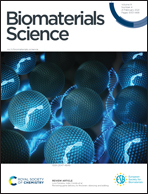Tunable phosphate-mediated stability of Ce3+ ions in cerium oxide nanoparticles for enhanced switching efficiency of their anti/pro-oxidant activities†
Abstract
Switching of the Ce3+/Ce4+ oxidation states in cerium oxide nanoparticles (CNPs) provides various superior nanozyme activities. However, nanozymes lack a switch to reversibly regulate the multi-nanozyme capacity depending on physiological/pathological environments, e.g. different pH and H2O2 levels. Furthermore, highly concentrated Ce3+ ions with abundant oxygen vacancies (Vo) in CNPs have the potential to enhance their catalytic activities, but the phosphate anions (P) adsorbed on Ce3+ ions block their several catalytic activities. This study, therefore, demonstrates that the tunable P-mediated stability of Ce3+ ions involves the superoxide dismutase (SOD) mimetic activity of CNPs, and leads to enhanced switching efficiency of their anti/pro-oxidant activities. Herein, highly concentrated Ce3+ ions in Vo-CNP layers (Vo-CNPLs) were fabricated, and the threshold conditions necessary to alter the stability of Ce3+ ions treated with P were explored by X-ray photoelectron spectroscopy. P-adsorbed Ce3+ ions (P-Ce3+) in Vo-CNPLs were efficiently destabilized in H2O2 solution (pH 5–6) rather than in HCl and HNO3 solutions (pH 3), and the presence of H2O2 readily released P from Ce3+ sites. Indeed, though P-Ce3+ temporarily arrested the SOD mimetic activity to generate H2O2 (linked to anti-oxidant activity) at physiological pH, they did enable the initiation of SOD mimetic activity (pro-oxidant activity) even at pH 5 close to biologically-appropriate acid conditions, e.g. in lysosome/endosome/tumor-microenvironments. These findings suggest that P-Ce3+ ions enhance the switching efficiency of their anti/pro-oxidant activities. Thus, P-mediated switches could be utilized to achieve a better understanding of the nanozyme switching-mechanisms, and for the design of multi-functional nanozymes for enhancing therapeutic efficacy.



 Please wait while we load your content...
Please wait while we load your content...